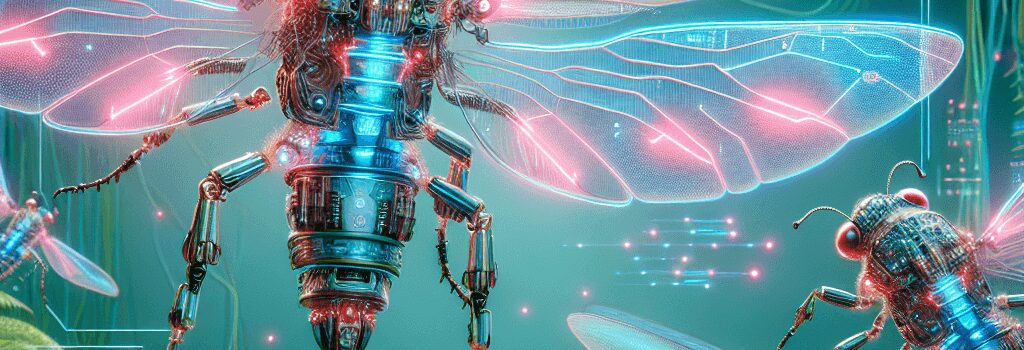Cyborg Cicadas: Merging Biology and Electronics for Alerts and Music

Introduction
Summer evenings in many parts of the world are defined by the rhythmic chorus of male cicadas. Their natural tymbal vibrations produce species-specific calls that can reach up to 100 decibels. Now, researchers at the University of Tsukuba have elevated this phenomenon by creating cyborg cicadas—insect–computer hybrid speakers capable of performing Pachelbel’s Canon. Detailed in a recent preprint on arXiv, the team’s breakthrough opens new avenues for biohybrid robotics, emergency communication systems, and advanced electrophysiological studies.
Background: From Roaches to Cicadas
Interest in cyborg insects dates back to the 1990s, when tiny electrodes were implanted in cockroach antennae to control locomotion for search-and-rescue missions. Notable milestones include:
- 2015, Texas A&M University: Electrode implants in the cockroach ganglion enabled 60% directional control, using a backpacked remote controller and micro-shocks to steer the insects.
- 2021, Nanyang Technological University: Madagascar hissing cockroaches outfitted with microcomputers and electrodes in sensory cerci achieved 94% steering accuracy in simulated disaster environments.
Inspired by these advances, the Tsukuba team targeted singing cicadas (Graptosaltria nigrofuscata) for their robust tymbal apparatus and larger body size, which simplifies surgical implantation and electrode placement.
Methodology: Hijacking the Tymbals
The researchers captured seven mature male cicadas and performed micro-surgical implantation under a stereomicroscope. Key steps included:
- Isolating the tymbal muscle region just below the anterior abdominal tergites.
- Affixing ultrafine silver wire electrodes (diameter ~25 µm) directly onto the tymbal muscles using biocompatible adhesive.
- Connecting electrodes to a lightweight tether, terminating at a custom amplifier circuit capable of delivering ±0.1–5 V stimulation pulses.
Microphones positioned 1 cm from each cicada recorded audio responses, while a digital voltmeter logged real‐time current flow. By varying pulse width (100–500 µs) and amplitude, the team mapped stimulus parameters to specific mechanical vibrations of the tymbal plates.
Technical Deep Dive: Electrophysiology and Signal Processing
The core challenge lay in translating digital musical notes into neurostimulation protocols. The workflow consisted of:
- Note-to-frequency conversion: MIDI-based signals ranging from 27.5 Hz (A0) to 261.6 Hz (C4).
- Signal conditioning: A programmable ARM Cortex-M4 microcontroller generated precise pulse trains, which were filtered by a low-pass Butterworth filter (cutoff 2 kHz) to remove high-frequency artifacts.
- Amplification stage: A two-stage operational-amplifier circuit (OPA379) boosted the microcontroller output to the required voltage range, with gain adjustable via digital potentiometers.
- Closed-loop feedback: Real-time audio capture allowed adaptive calibration of pulse parameters via a PID controller to stabilize pitch and amplitude over extended sessions.
Results: Playing Pachelbel’s Canon
After systematic calibration, the cicadas produced discrete pitches across more than three octaves. By sequencing stimulation patterns, the team coaxed the insects into performing recognizable musical phrases such as the opening progression of Pachelbel’s Canon. Spectrogram analysis confirmed harmonic fidelity within ±5% of target frequencies.
Potential Applications in Emergency Alert Systems
Beyond novelty performances, cyborg cicadas could function as low-power, eco-integrated signaling devices in remote or disaster-stricken areas. Possible use cases include:
- Autonomous alert networks: Swarms could broadcast preprogrammed acoustic warnings when triggered by environmental sensors (e.g., gas leaks, seismic activity).
- Mesh communication: Acoustic signals modulated with digital data could relay short status updates without reliance on satellite links or cell towers.
- Covert reconnaissance: Their silent approach and natural camouflage make them ideal for discreet monitoring in sensitive zones.
Ethical and Environmental Considerations
While the experiments reportedly caused no lasting harm, questions remain about the welfare of biohybrid organisms and ecological impact. Experts urge the development of stringent guidelines:
- Minimally invasive implant techniques and reversible interfaces.
- Lifetime monitoring to ensure normal feeding and mating behaviors post‐experimentation.
- Assessment of potential ecosystem disruption if cyborg insects were released into the wild.
Future Directions
Building on these findings, upcoming research will explore:
- Integration of 5G-enabled microtransceivers for real-time remote control and data telemetry.
- Machine-learning algorithms for adaptive stimulation, allowing each insect to self‐tune its output based on acoustic feedback.
- Advanced flexible bioelectronics (e.g., stretchable conductive polymers) to reduce electrode footprint and improve long-term biocompatibility.
Expert Opinions
- Naoto Nishida (University of Tokyo): “We confirmed that the cicadas remained behaviorally normal between stimulation trials, with some individuals even seeming to cooperate.”
- Dr. Sarah Wellington (Neural Engineering Institute): “This work pushes the frontier of biohybrid robotics. The closed‐loop control and signal‐processing pipeline are particularly impressive.”
Conclusion
The University of Tsukuba’s cyborg cicadas represent a remarkable fusion of entomology, electrophysiology, and signal engineering. As the field advances toward more sophisticated bioelectronic interfaces, insect–machine hybrids may soon play practical roles in environmental monitoring, disaster response, and beyond, all while reminding us that the boundary between living organisms and machines is more permeable than ever.